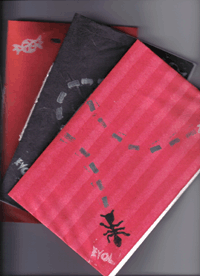DEMO: Layout Part 1, Setting up your layout document
Since all of you are using MSWord, this demonstration will be geared toward that software. I'm going to be talking about a digest-sized booklet (8.5 x 11, with landscape orientation), but the steps are the same for legal-sized paper. I use a Mac, so if you're on a PC your menus may look a little different. These are the same steps we discussed in Thursday's class.
Important: You must be sure your mock book "reads" properly and that you've allotted space for everything. Your page-count must be a multiple of 4 (because each sheet of paper will contain 2 booklet pages on the front, and 2 on the back).
To set up your layout, you'll need:
* Your computer with MSWord
Set up your document
1. Open a new document in MSWord.
2. Under the File menu, select Page Setup.
3. In the Page Setup window, select your paper size (letter or legal) and orientation (landscape, i.e. the little guy's head faces the right margin in the graphic).

4. Click OK. Your MSWord document should now reflect your chosen paper size and orientation. Save.
5. Under the Format menu, select Document.
6. Set your top, bottom, left & right margins. You must use the same margins you selected for your booklet page size in the mock book steps. The examples in that demo were for half-inch margins, so I've entered .5 for all. If you estimated wider margins, adjust them now. Click OK. Save.

7. Next, you'll set up your columns. (I'm demonstrating two columns per page, which is adequate for most books. Stephanie mentioned she may want to try 4 per sheet (for 2 columns per booklet page), but the idea is the same. Under the Format menu, select Columns. Click the graphic for 2 columns, or type 2 into the box. We estimated a 1" gutter (space between columns where your binding will go) in the mock book step, so enter 1 in that box. The column widths will automatically adjust. Click OK. Save.

8. Your layout document is all set up. Now you're ready to start pasting in your text. (Tip: If you plan to do other chapbooks in the future with this same format, do a Save As and name this second copy Chapbook_Template.doc or something similar. Each time you want to start a book, open your template and do a Save As under the name of the new project. You'll be ready to paste right away.)
Labels: demos



